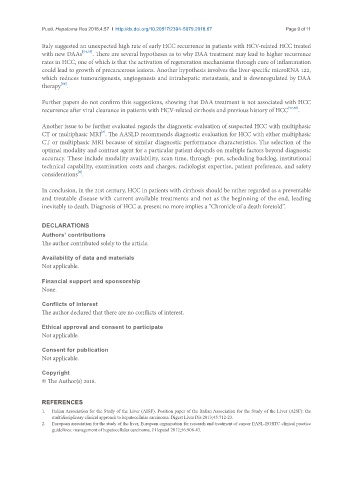Page 619 - Read Online
P. 619
Puoti. Hepatoma Res 2018;4:57 I http://dx.doi.org/10.20517/2394-5079.2018.67 Page 9 of 11
Italy suggested an unexpected high rate of early HCC recurrence in patients with HCV-related HCC treated
with new DAAs [54,55] . There are several hypotheses as to why DAA treatment may lead to higher recurrence
rates in HCC, one of which is that the activation of regeneration mechanisms through cure of inflammation
could lead to growth of precancerous lesions. Another hypothesis involves the liver-specific microRNA 122,
which reduces tumourigenesis, angiogenesis and intrahepatic metastasis, and is downregulated by DAA
[56]
therapy .
Further papers do not confirm this suggestions, showing that DAA treatment is not associated with HCC
recurrence after viral clearance in patients with HCV-related cirrhosis and previous history of HCC [57,58] .
Another issue to be further evaluated regards the diagnostic evaluation of suspected HCC with multiphasic
[8]
CT or multiphasic MRI . The AASLD recommends diagnostic evaluation for HCC with either multiphasic
CT or multiphasic MRI because of similar diagnostic performance characteristics. The selection of the
optimal modality and contrast agent for a particular patient depends on multiple factors beyond diagnostic
accuracy. These include modality availability, scan time, through- put, scheduling backlog, institutional
technical capability, examination costs and charges, radiologist expertise, patient preference, and safety
[8]
considerations .
In conclusion, in the 21st century, HCC in patients with cirrhosis should be rather regarded as a preventable
and treatable disease with current available treatments and not as the beginning of the end, leading
inevitably to death. Diagnosis of HCC at present no more implies a “Chronicle of a death foretold”.
DECLARATIONS
Authors’ contributions
The author contributed solely to the article.
Availability of data and materials
Not applicable.
Financial support and sponsorship
None.
Conflicts of interest
The author declared that there are no conflicts of interest.
Ethical approval and consent to participate
Not applicable.
Consent for publication
Not applicable.
Copyright
© The Author(s) 2018.
REFERENCES
1. Italian Association for the Study of the Liver (AISF). Position paper of the Italian Association for the Study of the Liver (AISF): the
multidisciplinary clinical approach to hepatocellular carcinoma. Digest Liver Dis 2013;45:712-23.
2. European association for the study of the liver, European organisation for research and treatment of cancer EASL-EORTC clinical practice
guidelines: management of hepatocellular carcinoma. J Hepatol 2012;56:908-43.

